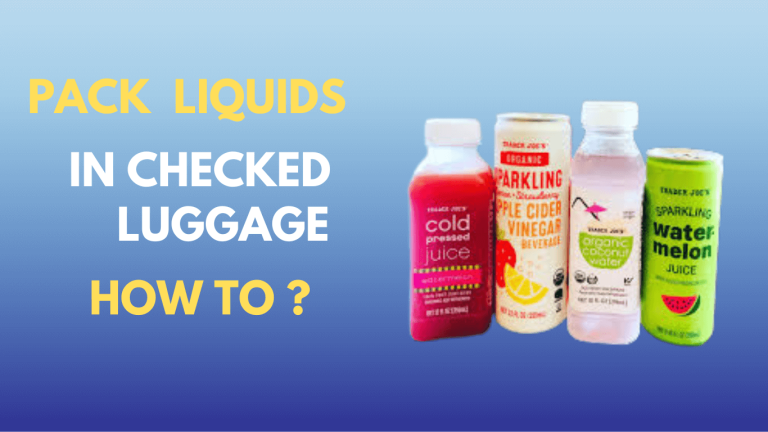Packing for a trip is a challenging task, especially when it comes to transporting liquids in your checked luggage for a flight. Packaging liquids properly is essential to avoid leakage or spills that could damage your belongings or the belongings of others.
Transportation Security Authority (TSA) and airlines impose rules and regulations for transporting liquids in your checked luggage. You must check the rules and regulations imposed by the airline and TSA to avoid any inconvenience.
This Article discusses all the aspects of how to pack liquids in checked luggage. We also discuss the types of liquids allowed on planes and prohibited by the FAA (Federal Aviation Authority) and TSA.
We also share tips to securely pack and place the liquid containers in your checked luggage. However, it’s better to check the rules and regulations of your specific airline and destination country to avoid any hassle.
Table of Content
- 1 TSA Liquids Checked Luggage Rules:
- 2 How Many Bottles of Liquid Can I Bring on A Plane Checked Baggage?
- 3 Where Do You Put Liquids in Checked Luggage?
- 4 How To Properly Label and Document Liquids in Checked Baggage?
- 5 How To Properly Package Liquids to Avoid Leakage or Damage:
- 6 Common Mistakes to Avoid While packing liquids in your checked luggage:
- 7 Final Thoughts on Taking Liquids in Checked Baggage:
- 8 Frequently asked questions: How to Pack Liquids in Checked Luggage
TSA Liquids Checked Luggage Rules:
The Transport Security Administration (TSA) follows the 3-1-1 liquid rule to carry liquids in carry-on luggage. You can pack liquids in 3.4 oz containers, which must be placed in a clear, quart-size plastic bag per passenger. But if you pack liquids in checked luggage, no need to pack in a 3.4 oz container or clear plastic bag. You can pack in large containers with tightly sealed packaging.
How Many Bottles of Liquid Can I Bring on A Plane Checked Baggage?
The Transportation Security Administration (TSA) does not impose specific limits on the number of bottles and quantity of liquid you can pack in your checked baggage.
Each airline has rules regarding the maximum weight and dimensions of checked baggage. It’s vital to check the liquid quantity, weight, and size limitations and rules imposed by your airline and the country where you travel in your checked luggage.
Where Do You Put Liquids in Checked Luggage?
It’s crucial to place liquid containers in your checked luggage properly. Make sure you place your liquid containers in the middle of the luggage, surrounded by clothes, towels, or other soft stuff. It will provide extra cushioning or padding to avoid damage and leakage of liquid containers.
It’s great to wrap all liquid containers in a plastic bag or use bubble wrap to seal them properly. You can also wrap these containers in clothes to provide an extra padding layer to avoid accidental leakage.
Using plastic containers to store and pack liquids in your checked luggage is better, as glass containers break more easily. Also, you can place barriers between containers to transport liquid containers safely.
How To Properly Label and Document Liquids in Checked Baggage?
Labeling and documenting liquids in your checked baggage is an excellent way to identify and comply with airline security regulations quickly.
If you want to label the outside of your luggage, use a permanent marker or attach a small tag to the outside of your checked baggage to indicate that liquid detail. Labels are beneficial if you are not carrying the liquid in its original container, which will help you quickly identify it.
Make sure that your labels are clear and stay secure to avoid any confusion. Labels help airport security personnel and luggage handlers quickly identify the presence of liquids and their details.
How To Properly Package Liquids to Avoid Leakage or Damage:
Liquids are very tricky to handle in checked luggage due to high risks of leakage or damage. Proper packing of all liquid containers is essential, and they must be tightly sealed. Always double check your liquid containers are tightly sealed to avoid any leakages.
Here, we discuss some tips that help in packing liquid containers.
Choose travel-sized containers:
Use travel-sized containers with tight-fitting caps or lids. Travel bottles have less leakage chances during the flight. You can also use travel-size toiletry containers or small plastic bottles with screw-on caps. Make sure that the lids are tightly sealed to avoid any damage.
Wrap in sealable plastic bags:
Packaging your liquid containers in sealable plastic bags is a good idea. It provides more protection in case of leakage. Use clear, quart-sized plastic bags and ensure they are appropriately sealed.
Place in the middle of luggage:
Place the wrapped or bagged liquid containers in the middle of your checked luggage, surrounded by clothing, towels, etc., to provide extra cushioning. It will help to buffer and absorb any impact during traveling.
Separate and cushion items:
You must wrap each container in a plastic bag or use protective padding such as bubble wrap or clothing. It provides extra padding to reduce the chances of any damage or leakage.
Check airline rules and regulations:
Different airlines have different rules regarding the transportation of liquids or weight and size limits of checked luggage. Always check airline rules and regulations before packing liquids in your luggage to avoid unpleasant situations.
Separately pack essential and non-essential Liquids in Checked Baggage:
Categorize essential and non-essential liquids in checked luggage. It’s important to pack according to your preferences and follow airline rules. Here Are some tips for packing them:
Packing of Essential liquids:
Essential liquids are necessary for personal care, hygiene, or medical purposes and must be packed preferably.
Pack prescribed medications and medical supplies in their original packaging and sealed them tightly. Keep them in your hand baggage if you need them during the journey.
Pack essential personal care liquids such as toothpaste, mouthwash, contact lens solution, and skin care products in travel-sized containers. Also, use bubble wrap or plastic bags to pack them tightly to avoid any leakage. Place them in a clear, quart-size plastic bag to bring in hand luggage as per airline rules.
Packing of Non-essential liquids:
Before packing non-essential liquids, you Must evaluate whether you truly need to pack non-essential liquids. If you can purchase them at your destination, it might be better to leave them behind.
Properly seal non-essential liquid containers to prevent leakage during transit by using plastic wrap or tape around the caps for extra security.
Also, keep non-essential liquids containers separate from essential ones to prevent contamination or damage in case of leakage.
Common Mistakes to Avoid While packing liquids in your checked luggage:
As discussed earlier, the best ways to secure your liquid containers in your checked luggage. Now, we discuss some common mistakes you must avoid preventing unpleasant situations.
Taking Prohibited Liquids in Checked Baggage:
A Lot of liquids are prohibited or limited by TSA or airlines from carry-on and checked luggage. Flammable or hazardous materials like gasoline, lighter fluid, bleach, or aerosol cans are prohibited. Also, Alcohol liquids above 140 proofs are not allowed on board.
Always Check the airline or transportation Security authority’s guidelines to know which liquids are not allowed on a plane.
Trying to take larger amounts of Liquids in Carry-on Bags Instead of Checked Baggage:
A common mistake is people pack more liquid containers in their hand luggage. Pack large amounts of liquid securely in your checked luggage to avoid hassle.
Overpacking liquids:
Pack only the necessary liquids in your checked luggage. Overpacking can increase the risk of leakage and security restrictions.
Improperly labeling containers:
If packing any necessary medications or medical liquids, ensure they are appropriately labeled and in their original packaging. Also, you may have a doctor’s prescription if required to avoid any security issues.
Also, due to the proper labeling of liquid containers, it’s easy for you to know about each liquid container without any confusion.
Final Thoughts on Taking Liquids in Checked Baggage:
Packing liquids in your checked baggage is tricky for first-time travelers. It is crucial to properly seal the liquid containers, avoid prohibited items, and place the sealed liquid containers in suitable places in your checked suitcase.
Always check your airline and TSA rules and regulations regarding packing liquids in your checked baggage for a smooth journey.
By following the above-discussed tips and tricks for packing liquids in your checked luggage, you have a hassle-free travel experience. So, pack smartly and stay informed about airline regulations for a smooth journey.
Frequently asked questions: How to Pack Liquids in Checked Luggage
following are the frequently asked questions about How to Pack Liquids in Checked Luggage
How to pack toiletries in checked luggage?
You can pack toiletries in plastic containers and wrap them in separate zip-top plastic bags or bubble wrap to avoid any leakage or damage.
How do you pack oil for travel?
You can pack oils in small travel-size containers. It’s great to seal these containers using leakproof caps or wrap them up in a zip lock bag to avoid any leakage or damage.
Will liquids explode in checked luggage?
No, liquids do not explode in checked luggage. However, temperature and pressure fluctuations on aircraft may cause liquid containers to leak or damage. Always use tightly sealed liquid containers in checked luggage.
Does deodorant or antiperspirant count as a liquid by TSA?
Yes, deodorant or antiperspirant counts as a liquid by TSA. You can pack these in a 23.4oz container and place them in a clear, square-size zipped plastic bag to carry in a carry-on. Also, use bubble wrap or a plastic bag to pack tightly in checked luggage.
Is mascara a liquid TSA?
Yes, according to TSA, mascara is a liquid and must follow the rules of packing liquids in checked luggage and carry-on.
Also, TSA listed anything easy to spread, spray, squirt, and smear as a liquid, including moisturizers, aerosols, foundation, nail paint, eyeliner, and mascara.
Do wet wipes count as liquid TSA?
No, baby wipes and wet wipes do not count as a liquid by TSA. So, “wet wipes, in any quantity, can be carried without any liquid restrictions.

